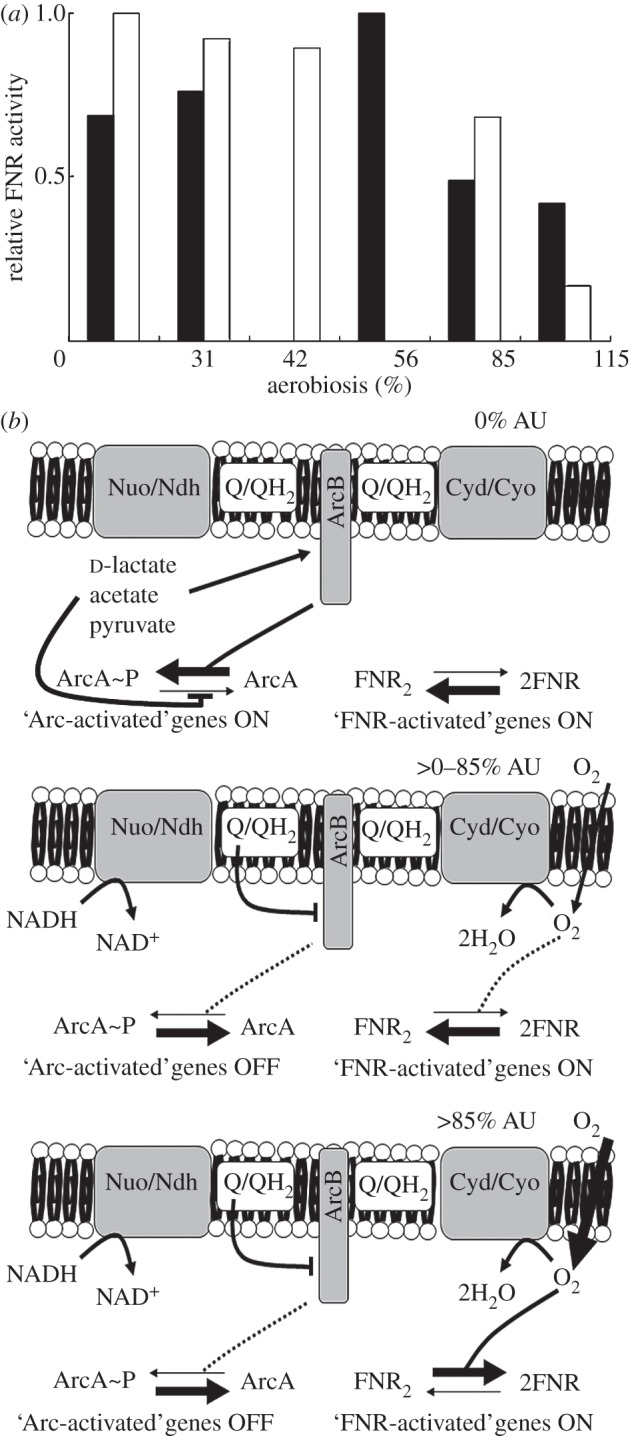Figure 2.

FNR activity under steady-state conditions. (a) The relative activity of FNR estimated from measurement of β-galactosidase activities from the model FNR-dependent FF-41.5 promoter fused to lacZ (data shown in table 1) in cultures grown at the indicated aerobiosis values (white bars). The black bars show the relative activity of FNR inferred from the transcript profiles at the indicated aerobiosis values (as shown in figure 1). In both cases, 1 represents the maximum activity. In the validation experiments (white bars), the chemostats set to achieve 56 per cent aerobiosis actually reached 42 per cent aerobiosis; thus only a single white bar is shown for 42 per cent aerobiosis and a single black bar for 56 per cent aerobiosis. (b) Model illustrating how oxygen consumption at the bacterial cell membrane is sufficient at aerobiosis unit (AU) values less than or equal to 85 per cent to exclude oxygen from the bulk of the cytoplasm. In the absence of oxygen (0% AU), the aerobic electron transport chain is inactive. ArcB autokinase activity is enhanced by: (i) the absence of inhibition by oxidized quinone (Q) [28]; and (ii) fermentation product (d-lactate, acetate, pyruvate) mediated activation of kinase activity and inhibition of ArcA∼P dephosphosphorylation [29,30]. The direct oxygen sensor FNR activates ‘anaerobic’ gene expression in the absence of oxygen [31,32]. Progress up the aerobiosis scale in the greater than 0–85 per cent AU range enhances flux through the aerobic electron transport chain (fed by the major primary dehydrogenases, Nuo and Ndh, and terminating in the major oxidases, Cyd and Cyo) such that oxidized Q is available to inhibit ArcB autokinase activity and the concentrations of fermentation products are lowered, resulting in conversion of ArcA∼P to inactive ArcA. However, FNR remains active, because the abundances of the terminal oxidases [4] are such that oxygen consumption at the membrane protects the cytoplasmic FNR iron–sulphur cluster from oxygen attack (dashed line). Thus, in this ‘micro-aerobic’ range, ArcA-activated genes are switched off but FNR-activated genes remain on. At aerobiosis values greater than or equal to 85 per cent (greater than 85% AU), ArcA is inactivated (dashed line) but the supply of oxygen now exceeds the rate of consumption at the membrane (table 1), exposing FNR to oxygen, thereby switching off FNR-activated genes. Thus, locating sensors in the membrane (ArcB) and the cytoplasm (FNR) allows optimal coordination of gene expression in the ‘micro-aerobic’ range. The model illustrates the data analysis provided in table 1.
